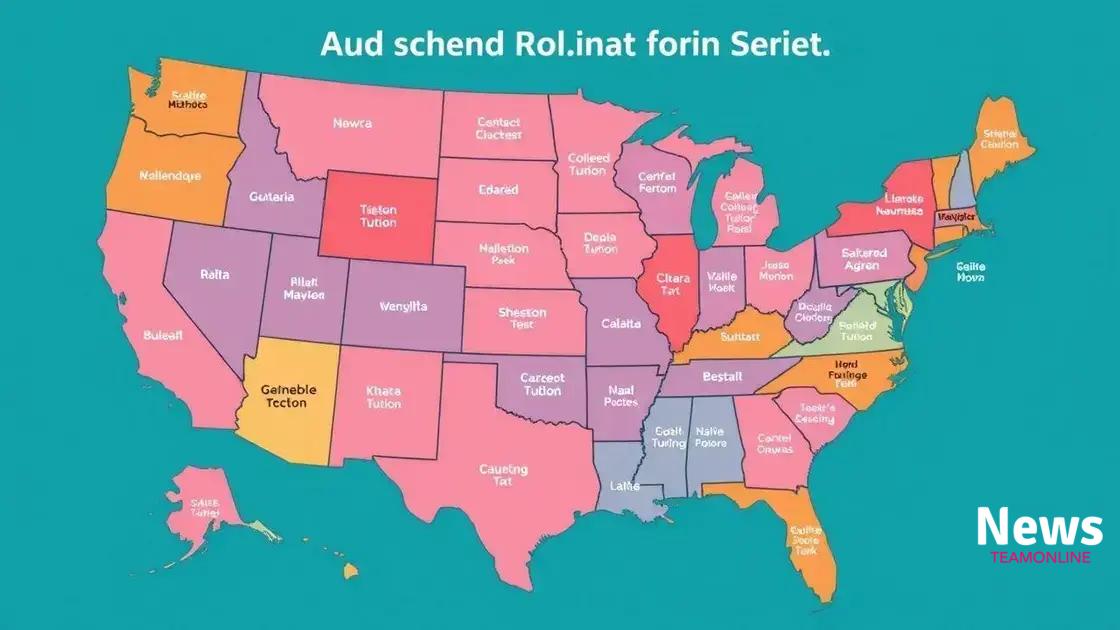Free college tuition program 2025: what you need to know

The free college tuition program provides eligible students the opportunity to attend public colleges without tuition fees, significantly reducing student debt and increasing access to higher education.
The Free college tuition program 2025 is generating a lot of buzz—and for good reason. Imagine pursuing your dream education without the burden of overwhelming costs. In this article, we’ll dive into what this program means for students and how you can take advantage of it.
Overview of the free college tuition program
The Free college tuition program offers many students a chance to achieve their educational goals without the heavy burden of tuition fees. This initiative aims to provide accessible education to everyone, regardless of their financial background. Understanding this program can help students and families plan their future more effectively.
What is the program about?
This program is designed to help eligible students attend college for free. It covers tuition at public colleges and universities, relieving them of financial stress. Several states are already implementing their own versions, which can differ significantly.
Types of Coverage
- Full coverage: Some states may provide complete tuition coverage for eligible students.
- Partial coverage: Others might only cover a portion of the tuition, requiring students to find additional funding.
- Income-based eligibility: Many programs focus on students from lower-income households.
- In-state vs. out-of-state: Benefits can vary depending on residency status.
Expanding knowledge about the free college tuition program allows students and their families to take proactive steps. It encourages discussions about different funding options and impacts on future job prospects. When students know what to expect from these programs, they can make informed decisions.
Participating in this program doesn’t only alleviate financial concerns; it promotes equality in education. By removing tuition fees, schools open doors for ambitious minds eager to learn. Thus, the program not only enhances individual opportunities but also contributes to a more educated workforce overall.
Stay informed about how the free college tuition program might evolve. Monitoring changes in eligibility and benefits will help students maximize their educational potential. This initiative is a significant step towards reducing student debt and broadening access to higher education.
Eligibility criteria for 2025
The eligibility criteria for the free college tuition program 2025 play a crucial role in determining who can benefit from it. This program aims to create opportunities for students from varied backgrounds. Understanding these criteria will help families assess whether they qualify.
General Requirements
To be eligible for the program, students typically need to meet certain basic requirements. These often include:
- Residency: Applicants usually must be residents of the state offering the program.
- Enrollment status: Students must be enrolled in an accredited public college or university.
- Academic performance: Many programs require a minimum GPA for eligibility.
- Age restrictions: Some programs may have age limits for applicants.
These criteria help ensure that those who truly need assistance receive it. However, eligibility can vary widely by state. Each state may include different measures for the program, so it’s essential to research local guidelines.
Income-Based Considerations
Income level is often a significant factor in determining eligibility. The goal is to support students from families with limited financial resources. Some programs have specific income thresholds, while others may consider income on a sliding scale.
Additionally, students may need to provide financial documentation, such as tax returns, to prove their eligibility for financial assistance. Understanding these requirements allows students to prepare adequately and increase their chances of receiving support.
Finally, keep in mind that some state programs also include additional stipulations. Programs may focus on different student demographics, including first-generation college students or those from underrepresented backgrounds. Checking the specific guidelines for your state is vital for ensuring eligibility.
How the program differs by state

The free college tuition program varies significantly from state to state, leading to unique opportunities and challenges for students across the country. Each state designs its program based on local needs and financial resources, which can affect tuition coverage, eligibility, and application processes.
State-Specific Features
Some states provide full tuition coverage, while others may only cover part of the tuition costs. For example, in California, residents can benefit from a comprehensive program that aims to cover all tuition fees at public colleges. In contrast, less populous states might offer limited funding, leading to a different set of rules and regulations.
- Funding sources: States may use different funding mechanisms, including state taxes or federal grants.
- School type eligibility: Some states allow only public institutions, while others may include private colleges.
- Duration of coverage: The length of coverage can differ; some programs renew annually, while others may last throughout the entire college experience.
In addition to financial differences, eligibility requirements can also change. For instance, while many programs target low-income families, states like New York have established programs that broaden eligibility to include middle-class families. This allows more students to access the benefits of the tuition program.
Application Procedures
The application process is another area where differences are notable. Some states have streamlined applications that allow students to apply through a single online portal, while others may require multiple forms and additional documentation. Being aware of these processes is essential for students wishing to maximize their chances of securing funding.
Understanding how the program varies by state helps students and families navigate their options effectively. Smooth navigation through the specifics can make a significant difference in accessing the funds necessary for higher education.
Impacts on student debt
The free college tuition program has the potential to significantly impact student debt across the United States. By eliminating or reducing tuition costs, this program aims to help students pursue higher education without the fear of accumulating massive debt.
Reducing Overall Debt Levels
One of the primary ways this program affects student debt is by reducing loan amounts. When students can attend college without tuition fees, they are less likely to rely on student loans to cover their education costs. This leads to smaller debt burdens upon graduation.
- Lower loan amounts: Fewer loans mean that students can graduate with less financial liability.
- Reduced interest costs: Less debt also translates to lower interest payments over time.
- Increased affordability: Students can focus on essentials without the strain of tuition expenses.
Additionally, the free college tuition program can open doors for students who might otherwise forgo higher education due to financial constraints. This increase in access can lead to a more educated workforce, stimulating economic growth and leading to higher earning potential for graduates.
Changing Perceptions of Higher Education
The presence of free tuition programs also shifts societal views on the value of higher education. As education becomes more accessible, more students may pursue degrees, recognizing that higher education does not come with overwhelming financial consequences. This cultural shift can help normalize the pursuit of degrees across various demographic groups, promoting equity in educational attainment.
In the long run, the reduction of student debt can contribute to a healthier economy. Graduates burdened with debt often delay major life decisions, such as buying homes or starting families. By lessening these financial pressures, the free college tuition program has the potential to enhance not only personal finances but also overall economic stability.
Strategies for applying successfully
Applying for the free college tuition program can feel daunting, but having effective strategies can make the process smoother. Several key steps can help ensure you meet all requirements and submit a strong application.
Research Your State’s Program
Every state has different rules and funding for their tuition programs. Take the time to research the specific requirements and deadlines for your state. This information is essential to make sure you don’t miss any necessary steps. Use official state education websites to find accurate details.
- Know the deadlines: Each state has different application dates. Be mindful of these.
- Check eligibility requirements: Understand who can apply and any specific conditions.
- Stay informed: Follow updates on policies or changes to the program.
Being well-informed can save time and avoid mistakes during the application process. Additionally, reaching out to local educational institutions can provide personalized guidance.
Gather Required Documentation
Before applying, ensure you have all necessary documents ready. Common documents include:
- Financial information: This often includes tax returns or income statements.
- Proof of residency: Many states require proof that you live there.
- Academic records: Collect transcripts as some programs ask for GPA information.
Having these documents organized will help you complete your application more efficiently. It’s a good idea to make a checklist to ensure nothing is missed. This step is crucial, as missing documentation can delay your application or even lead to disqualification.
Submit Early and Follow Up
Once you have everything ready, submit your application early. This proactive approach can help avoid last-minute issues. After submitting, it’s wise to follow up with the appropriate office to confirm that your application was received and to check if any further information is needed.
By taking these steps, you position yourself well for a successful application to the free college tuition program, ultimately enhancing your chances of receiving financial support for your education.
free college tuition program offers an exciting opportunity for students to pursue their academic dreams without the burden of debt. By understanding eligibility requirements, diverse state programs, and effective application strategies, students can maximize their chances of success. This program not only helps reduce student debt but also encourages more individuals to seek higher education, fostering a more educated workforce. It’s essential to stay informed, prepare well, and take advantage of the resources available. Embrace this chance to invest in your future and explore the doors that education can open!
FAQ – Frequently Asked Questions about the Free College Tuition Program
What is the free college tuition program?
The free college tuition program allows eligible students to attend public colleges without having to pay tuition fees, making higher education more accessible.
Who is eligible for this program?
Eligibility varies by state but typically includes residents who meet income criteria and are enrolled in an accredited public college.
How do I apply for the program?
Research your state’s specific application process, gather required documents, and submit your application before the deadline.
What are the benefits of the program?
The program helps reduce student debt, increases access to education, and encourages a more educated workforce, positively impacting the economy.





